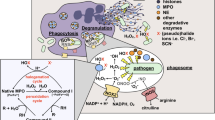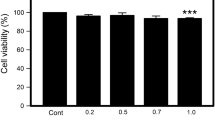Abstract.
Objective and Design: The myeloperoxidase system of neutrophils generates chlorinating and brominating oxidants in vivo. The major haloamines of the system are taurine chloramine (TauCl) and taurine bromamine (TauBr). It has been demonstrated in vitro that TauCl exerts both antiinflammatory and anti-bacterial properties. Much less is known about TauBr. The present study was conducted to compare bactericidal and immunoregulatory capacity of TauBr with that of the major chlorinating oxidants: HOCl and TauCl. Moreover, the effect of nitrites and H2O2 on TauBr activity was investigated.
Materials: TauBr was prepared by reaction of HOBr with taurine. The reaction was monitored by UV absorption spectra.
Methods: Bactericidal activity of TauBr, TauCl and HOCl was tested by incubation of E. coli with the compounds and determined by the pour-plate method. To test the anti-inflammatory activity the compounds were incubated with LPS and IFN-γ stimulated murine peritoneal macrophages. The production of following mediators was measured: nitrites by Griess reaction; TNF-α, IL-6, IL-10, IL-12p40 using capture ELISA. In some experiments the compounds were incubated with either nitrites or H2O2.
Results: In our experimental set-up TauBr and HOCl exerted strong bactericidal effects on E. coli (MBC = 110 μM and 8 μM, respectively), while TauCl (< 1000 μM) did not kill test bacteria. However, both, TauBr and TauCl, at noncytotoxic concentrations (< 300 μM) inhibited the cytokine and nitric oxide production by macrophages. H2O2 completely abolished the biological activities of TauBr but not those of TauCl. Nitrites did not affect any activity of TauBr or TauCl while they diminished the HOCl− mediated bacterial killing.
Conclusion: TauBr, despite very low concentration of Br− in body fluids, may support TauCl and HOCl in the regulation of inflammatory response and in killing of bacteria by neutrophils. However, TauBr activity in vivo will depend on the presence of H2O2 and possible other mediators of inflammation which can compete with target molecules for TauBr.
Similar content being viewed by others
Author information
Authors and Affiliations
Corresponding author
Additional information
Received 16 August 2004; returned for revision 16 September 2004; accepted by A. Falus 13 October 2004
Rights and permissions
About this article
Cite this article
Marcinkiewicz, J., Mak, M., Bobek, M. et al. Is there a role of taurine bromamine in inflammation? Interactive effects with nitrite and hydrogen peroxide. Inflamm. res. 54, 42–49 (2005). https://doi.org/10.1007/s00011-004-1322-9
Issue Date:
DOI: https://doi.org/10.1007/s00011-004-1322-9




